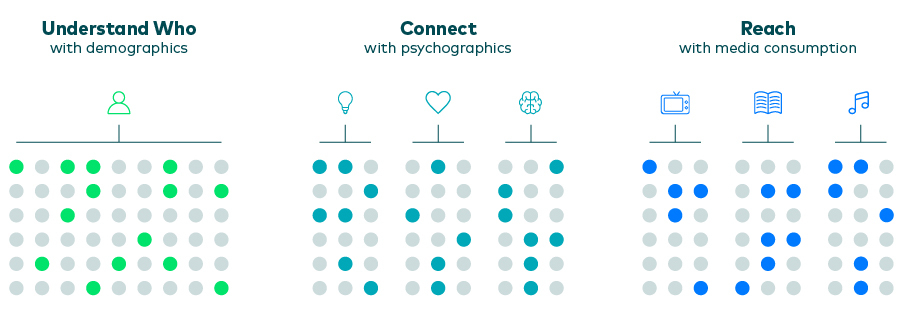Psychographics is the study of people’s lifestyles, attitudes, interests, beliefs, emotions, values, and aspirations. Measuring psychographic attributes gives marketers insight into consumer motivations and the ability to go beyond “who” to dig deeper into “why.”
What Is Psychographic Segmentation?
Psychographic segmentation is a process used by brands and retailers to divide consumers into groups based on their psychological attributes. There is almost no limit to what types of segmentations you can build based on consumer interests, attitudes, lifestyles, and beliefs. Measuring and understanding these consumer groups help marketers build targeted marketing efforts to influence consumer purchase decisions.

Examples of psychographic segmentation groups include:
- Sports fandom
- Media consumption
- Pet ownership
- Eating habits
- Social media usage
- Exercise activities
Psychographics vs Demographics
Traditionally, marketers have relied on demographics data to develop strategies that target the right audience. Demographic attributes such as age, gender, urbanicity and income are all standard ways of segmenting consumers. Other characteristics like ethnicity, marital status, children, education level and occupation may be used as well to add context.
This information is important, as it helps you paint a picture of who you’re targeting. But demographics don’t go nearly far enough, especially in today’s saturated, highly fragmented marketplace. This is where psychographics come into play. Retailers and brands can utilize psychographic data to understand what drives consumer behavior and better serve their wants and needs.
How Psychographics and Demographics Work Together
If someone buys an organic product, it’s helpful to know the person’s age, location, marital status, and household income. But if you really want to understand and connect with that individual or household, you need to look beyond demographics, and dig deeper into psychographic variables, answering questions such as:
- Why does this person buy organic?
- How much are they willing to pay for organic vs regular?
- How do they feel about environmental issues?
- Are they healthy eaters?
Psychographics add texture to demographics, creating a 360-degree view of the consumer. This brings you closer to the consumer and provides the insights you need to develop marketing strategies that resonate with them.
For example, demographic data such as household size and children’s ages could explain why someone went to the store to buy baby formula. But why did that shopper buy the more expensive organic option? Psychographics helps you answer these kinds of questions so you can market to real people, not just demographics.
How Is Psychographic Segmentation Used?
It goes without saying that if you try to market to everyone, you’re going to lose relevancy to your true ideal customer. By layering psychographics on top of your demographic data, you can create the right message in the right place and in the right format for your audience.

Suppose your brand is launching a plant-based burger. Psychographics can help you segment consumers who are on the vegan, vegetarian or ‘flexitarian’ diets. Perhaps they are simply health-conscious or just curious eaters.
By understanding the size of each of these groups, as well as other beliefs, attitudes, and behaviors within each group through psychographic segmentation, you can determine the best way to market your latest menu item. You can also determine if it would be worthwhile to develop secondary messaging for healthy eaters who may be curious about plant-based products, but not as motivated by specific dietary restrictions.
Using psychographic data to segment your audience and inform your marketing strategy leads to more relevant, effective messaging and more successful commercial efforts. Psychographics make it possible to answers questions such as:
- What does your ideal customer care about most?
- Which factors are most important in their decision making?
- What levers do you need to pull to move your ideal customer from consideration to purchase?
How to Find Reliable, Useful Psychographic Data
Psychographic data points are typically collected via survey. The key is to use a consumer panel that’s large enough and engaged enough to consistently provide you with ongoing profiling data. For example, brief microsurveys performed in the moment, integrated into the panelist experience, give you the ability to identify hundreds of psychographic attributes over time.
Issuing frequent, but brief microsurveys (no more than three questions) increases the likelihood for high participation rates and accurate, reliable data, yielding a coverage factor of 95-99% across our measurement panelists. Many of the microsurveys are refielded on a rolling 12 month basis to ensure fresh and current insights at all times. Lengthy questionnaires, on the other hand, tend to have a negative impact on participation and can age quickly.
Topics that you could uncover through microsurvey questions include (but are certainly not limited to):
- Media consumption habits and influences (TV, social, print, audio, technology, etc.)
- Perceptions of advertising and its influence on behavior
- Cooking habits and drivers of dining behavior
- Views on health and sustainability issues, such as nutrition and recycling
- Attitudes on shopping and opinions on various products
How to Use Psychographic Data
The use cases are virtually endless when you have a large, engaged panel of consumers who are continuously providing feedback on their attitudes, opinions and shopping behaviors. For example:
- An oral care brand can determine which brand of toothpaste is most popular with dentists
- A BevAl brand can profile the attitudes and behaviors within the LGBTQ+ community
- A snack manufacturer can assess the value of potential partnerships by sport or even specific teams
- A brick-and-mortar retailer can add context to how much of a threat eCommerce represents to specific consumer segments
- An emerging CPG brand can paint a picture of the type of shoppers they attract to convince a major retailer for additional shelf space
Psychographic Segmentation Will Drive Personalization
One of the biggest changes in the marketplace during the past 10 years has been consumer demand for personalized experiences. Targeted ads on Google, YouTube, Facebook, TV, streaming audio platforms and more have already become a standard expectation, while irrelevant ads increasingly struggle to resonate with audiences.
Retailers and brands can only deliver on the promise of personalization if they use psychographics to understand what’s in the heart and mind of a specific target market. The days of advertising to reach broad demos like 18-34 year old males are drawing to a close.
Advertising is likely to become even more granular and hyper-targeted. You may even end up with various versions of the same ad to deliver to different household segments based on the behaviors, influences, and preferences of each segment.

It’s no longer about reaching an audience. It’s about connecting with that audience, and doing so requires a deep understanding not just who they are but what they care about.
That’s what psychographics provides to retailers and brands. And that’s the key to winning in today’s marketplace.
***
Did you know that Numerator maps more than 500 psychographic attributes and 300 media consumption habits to the shopping behavior of more than 100,000 shoppers? Drop us a line and we’ll show you new ways to understand and connect with your brand’s consumers.

